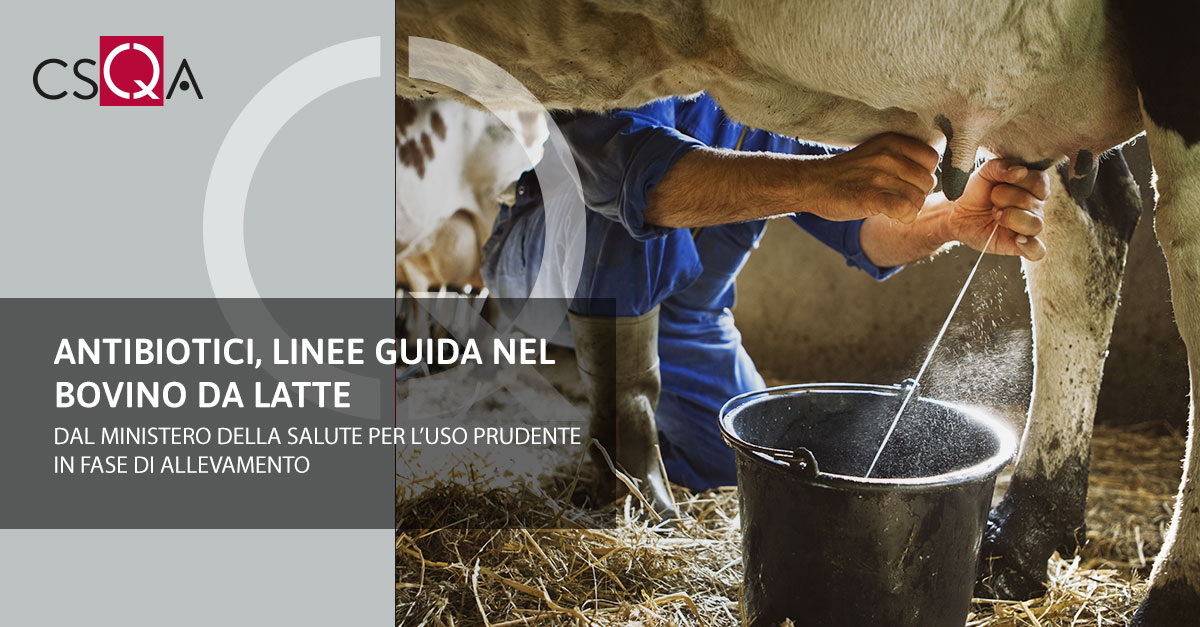 With the new "Guidelines on the prudent use of antibiotics in dairy cattle breeding" the Ministry of Health makes an operational document available to Veterinarians and Operators for an appropriate use. Focus on diagnosis and treatment of frequent pathologies.
With the new "Guidelines on the prudent use of antibiotics in dairy cattle breeding" the Ministry of Health makes an operational document available to Veterinarians and Operators for an appropriate use. Focus on diagnosis and treatment of frequent pathologies.Drawn up under the coordination of Emilia Romagna, the guidelines offer guidelines valid on a national scale. The scientific societies SIVAR and SIB collaborated in the drafting.
At the end of a process of in-depth analysis, open to contributions from freelance veterinary surgeons, the General Directorate of Animal Health and Veterinary Medicines publishes the Guidelines on the prudent use of antibiotics in dairy cattle breeding.
The document was drawn up under the coordination of the Emilia Romagna Region, to which the Conference of Regions had conferred the task of arriving at guidelines valid on a national scale.
The adoption of specific guidelines is envisaged by the National Plan to Combat Antimicrobial Resistance (PNCAR 2022-2025).
A practical and comparative document
The document is a streamlined act, with a practical-operational orientation, which solicits the attention of all the figures involved: veterinary surgeons, operators and personnel in charge of animal care .The guidelines are characterized as a "non-mandatory" document , a useful tool for "sharing the problems posed by antimicrobial resistance among veterinary surgeons operating in the primary production sector and those employed in public institutions (Regions, Health Authorities, Experimental Zooprophylactic Institutes, University, etc.).
The document is noted for the purpose of "implementing a constant comparison between competent authorities, operators and company veterinarians, regarding the reasoned choices of treatment of the animal".
Necessity and responsibility
The use of antibiotics, even when "necessary", must always be "responsible", according to a respectful use of the indications for use, only for therapeutic purposes and following a specific diagnosis. Administrations for prophylactic and metaphylactic purposes should be avoided or in any case strongly limited.The guidelines call for particular attention to critically important antibiotics as the last therapeutic arsenal for multidrug-resistant infections in humans.
"Critical points of fundamental importance"
The Guidelines place the emphasis on the diagnosis and treatment of the most frequent pathologies in cattle . With "operational purposes", the guidelines summarize the critical points and interventions aimed at encouraging the prudent use of antibiotics, reducing their inappropriate use.Prudent use will have to focus on some aspects emphasized as "critical", in particular:
- proper management of calves;
- the prevention of foot pathologies;
- the correct management of the birth and of the animals in the transition phase;
- the prophylaxis of dry mastitis;
- the adoption of an appropriate diagnostic procedure aimed at the most targeted use of the antibiotic
Classyfarm and Rev- The ClassyFarm checklists for the self-monitoring assessment of animal welfare and biosecurity in ruminant populations can be an important support for identifying the major critical points of breeding in terms of animal welfare, entry of new pathogens (biosecurity external) and their diffusion within the farm (internal biosecurity).
It is also "very important" to be able to quantify and harmonize data on antibiotic consumption through the use of standardized units of measurement (DDD), as envisaged within the ClassyFarm system, thanks to the data collected through the Recipe Veterinary Electronics.
Structure of the Guidelines
The document is divided into chapters. The chapter dedicated to biosecurity and livestock management indicators provides tables to facilitate the actions to be taken, the procedures to follow, the use of pesticides.Pending the issuing of a specific national regulation, the main biosecurity and animal welfare measures to be considered in drafting the Health Management Plan are reported.
The chapter on diagnosis , as a requirement for prudent antibiotic use, recommends a minimal diagnostic protocol. Particular attention is paid to mastitis , "currently the pathology that involves the greatest use of antibiotics in dairy cattle breeding".
For the assessment of antibiotic sensitivity in vitro and interpretation, the guidelines refer to the break-points provided by international organizations such as the Clinical Laboratory Standard Institute (CLSI) and to the indications of the National Reference Center for antimicrobial resistance. In the chapter dedicated to therapy, we offer - among others - indications for the choice of therapy with regard to first, second and third choice antibiotics.
Concertation
The Guidelines arise from a fruitful consultation phase, shared with the Scientific Societies Sivar (Italian Society of Veterinarians for Farm Animals) and Sib (Italian Society of Buiatry) .GUIDELINES FOR THE PRUDENT USE OF ANTIMICROBIALS IN MILK CATTLE.pdf1.25 MB